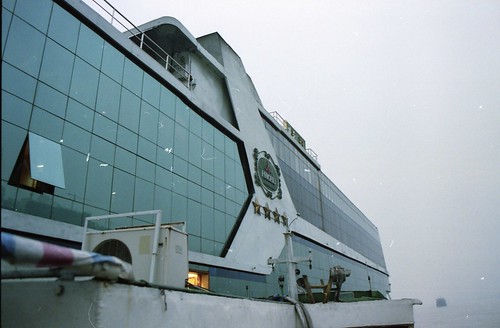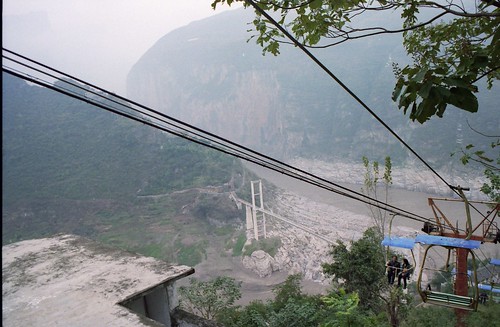In 2002, I made my first visit to China. I'd not heard of 'blogging' then (there's an interesting history of blogging in Ryan Robinson's blog here) so it was not until 2007 that I started to describe this trip in the post China. At that time, I was still using a 35mm roll-film Canon 'EOS' camera so I was quite sparing in taking photographs and those I did take didn't get scanned and made available on the internet for years.
The 2007 post covers Beijing area (Tiananmen Square, the Forbidden Palace, solo tour of the city and its subway, next day Ming Tombs, Chinese Hospital, Cloisonne factory, the Great Wall), flying to Xian (City Wall, Buddhist Monastery, Big Wild Goose Pagoda, next day Terracotta Army, Flying to Chongqing (board Yangtse cruise ship 'Pinghu', next day start our journey dowmnstream). Then, the description stops with the cheerful comment "I hope to tell you more later". I didn't return to the topic until I talked about an incident in Beijing right at the end of the trip in the post here. That finally induced me to finish describing my introduction to China but with few pictures to prompt the memory and any contemporaneous notes lost long ago, it will be a little sketchy.
The Yangtse River
The Yangtse cruise proved a good choice as it enabled me to see some of the contrasts China offers, start to understand the importance of the river as an ancient highway and appreciate the breathtaking scope of some of the projects being undertaken in China as it asserts its place in the modern world.

Chongqing-Yichang Yangtse River Cruise (Map: China Discovery)
As described here I'd boarded 'Pinghu' in the dark one evening and the following morning we set off downstream with the weather misty and occasionally rainy. I think Fengdu Ghost City on the northern bank was our first stop, where I gathered contrasting impressions of an ancient temple on high ground and a modern town being demolished virtually by hand prior to inundation. As we continued downstream, there were demonstrations of Chinese arts and crafts on board.

My cruise ship 'Pinghu', viewed from tender taking us ashore.

My cruise ship 'Pinghu', moored midstream in the Yangtse viewed from tender taking us ashore. Note the modern hilltop town top right of the picture.

My cabin aboard 'Pinghu' (Yangtse River Cruise)
Our next visit was to Baidicheng (which means white emperor city), an ancient hilltop fortress and temple complex offering views downstream towards the first of the Three Gorges we would pass through on our cruise - the Qutang Gorge. We had to climb a long, steep path to reach the site and I was rather tempted by the offers of transport to the top by groups of porters using home-made 'sedan chairs' comprising a sort of deck-chair with a simple roof fixed to a stout carrying beam. Resisting temptation, I made it both ways under my own power.

The steep path from the landing place to Baidicheng (Yangtse River Cruise)
I enjoyed wandering around the temple site which commanded good views of the Yangtse River and the Qutang Gorge we would cruise next. I've included a picture of Jan with a carved female guardian lion (Jan is on the left)

Jan and carved female guardian lion at Baidicheng (Yangtse River Cruise)

View of chair lift, suspension bridge and Qutang Gorge at Baidicheng in 2002 (Yangtse River Cruise)
The weather didn't improve as we made our way downstream. It was certainly 'atmospheric' but a bit damp. We passed through the Wu Gorge and went ashore for an excursion on a much smaller boat on a 60 km long tributary of the Yangtse called the Shennong Stream. It's an area of great beauty which I'm afraid we didn't see at its best. The rain sluiced down remorselessly so I didn't risk taking a camera but you can read a modern description of the area here, which talks about 'sampan drifting' in an unpowered, wooden-hulled double-ended craft (sometimes called a 'pod boat' because of its shape). We boarded one of these boats, with two helmsmen, one each end, each provided with a large oar principally used for steering. Of course, initially we were heading against the current so motive power was provided by a line of men scrambling along the bank ahead of us, man-hauling on a substantial rope attached to our vessel. The weather conditions made it difficult for the men to keep their balance and I witnessed a number of near-accidents. To add to the incongruity of the scene, all the haulers had donned plastic ponchos to keep out the worst of the weather. When the helmsmen decided we'd gone far enough, one of the shore party scrambled aboard the boat, bringing the haulage rope with him, leaving the rest of the men to make their way back to the loading point and, presumably, do it all again. Even in the rain and with impaired visibility, it was very pleasant to be silently drifting with the current back to our boarding point and it seemed a different world from the commercial bustle of the Yangtse with its procession of cargo ships and passenger ferries in both directions, occasionally punctuated by the loud exhaust of the hydrofoil ferries. Once safely back aboard 'Pinghu' and with the opportunity to dry-out, our journey continued into the third gorge - Xiling Gorge.
Despite the generally indifferent weather, I spent a fair bit of time outside on the upper deck, trying to absorb the majesty of the deep gorges and trying (but failing) to imagine the changes completion of the Three Gorges would bring, with the river level raised three hundred feet.

Signs on riverbank indicating planned rise in water level. The upper sign indicates 175m above sea level - the planned river level after completion of the Three Gorges Dam (Yangtse River Cruise)

Passing through the Three Gorges of the Yangtse River before inundation (Yangtse River Cruise)
The picture above also shows the mast on 'Pinghu' and the 'christmas tree' effect created by the various branches carrying navigation lights. After dark, I spent some time on the outside upper deck, fascinated by the amount of river traffic still moving, with the different displays of navigation lights indicating each ship's status - anchored, under way, towing.
I was disappointed by the actual Three Gorges Dam site. Although there was plenty of earthmoving going on, I'd failed to fully appreciate that we were passing what would become the base of the dam and that the impressive appearance of a large dam would only appear later. Our cruise terminated at Yichang where a large number of ferries were moored.

Ferry moorings at Yichang (Yangtse River Cruise)
I met up with a local guide who took me by car to the Chinese Sturgeon Museum set up in 1982 which is attempting preservation of this endangered species. There were interesting displays but I found the large, tiled pools housing live Chinese Sturgeon rather depressing, I'm afraid. There's a Wikipedia article here.

Chinese Sturgeon Museum, Yichang (Yangtse River Cruise)
Next, we visited Yichang Museum where there was a very well-displayed exhibition of artefacts from the area, many uncovered during the massive civil works involved in relocating towns along the Three Gorges at a higher level. Finally, I was taken to the Gezhouba Dam with its Navigation Locks allowing ships up to 10,000 tons to by-pass the dam. This project, started in 1970, was completed in 1988 and the 47 metre high dam has a generating capacity of 2.71GW. The scale of the ship locks is impressive but I was particularly taken by the almost continuous stream of pedestrians slowly making their way across the river, in both directions, using the walkways built along the top of the lock gates.

Gezouba: Navigation Lock Gate (Yangtse River Cruise)
My guide then took me to Yichang airport for my internal flight back to Beijing. Back in Beijing, I was returned to the same hotel I'd used on my arrival in Beijing to prepare for my final flight home. It was on a walk in Beijing before my transfer to the international airport that I had the unfortunate brush with the local police described here. Despite that hiccup, it had been a wonderful trip and I'm pleased that I got to see the Three Gorges before the dam was completed.
Related material on other websites
China's Mighty River (1930s article from 'Shipping Wonders of the World).
Yangtse River (Facts and Details site)
Chinese Sturgeon (Wikipedia)
My pictures of the 2002 trip
Beijing, China
Xian, China
Yangtse River, China
